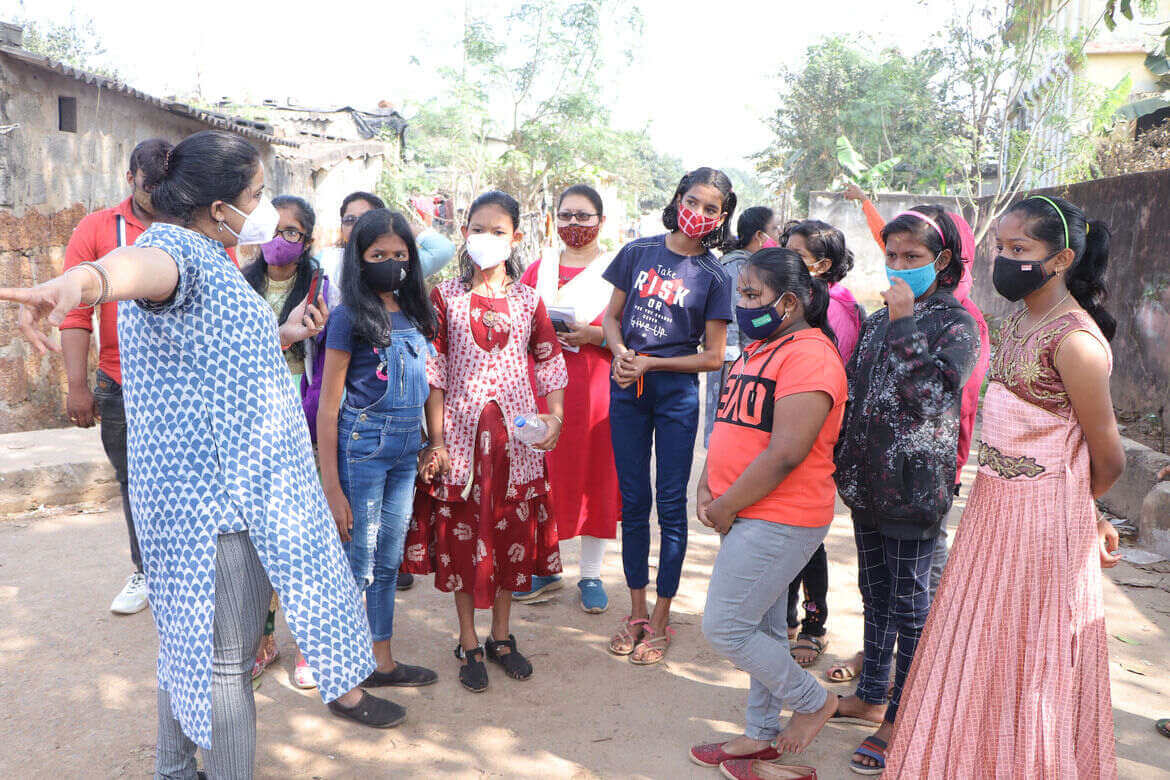Youth-Led Urban Development: A Participatory Approach to Improving Public Spaces

Disclaimer: All pictures are of participants in the Healthy Cities for Adolescents (HCA) project and have been taken with their consent.
This is the first in a series of blogs on Adolescents and Public Spaces. In this, we talk about how adolescents can partake in the public space development process and lead public space initiatives contributing to their well-being.
India’s potential for growth rests on the investments in and development of its youth, with every third person falling within this cohort. This leads to the question of harnessing the youth’s potential. Are our cities equipped to respond to their growing needs, providing them with opportunities for leadership and representation in the decision-making processes?
Adolescence (10-19 years) is the phase of youth that transitions from childhood into adulthood and 20.9 % of the total population of India is constituted by adolescents. They have the potential to lend new perspectives, develop innovative solutions and drive change among peers, families, and communities. These qualities of adolescents have allowed them to be agents of change through initiatives within sectors such as education, health, and skill development.
National programs such as Rashtriya Kishor Swasthya Karyakram create awareness about adolescent health through peer educators. A similar approach is observed in adolescent education programs under the revised National Education Policy 2020.
There is, however, a paucity of urban development initiatives that factor in adolescent participation. This is evident especially when it comes to the development of public spaces in cities. Here, adolescent needs and capacities are rarely taken into consideration, making public spaces in Indian cities inaccessible or unsafe for adolescents.
Safe and accessible public spaces, as components of urban infrastructure, are vital for adolescents as they serve as an interface with the external world, allowing them to be independent and partake in activities that contribute to their overall physical and mental well-being.
Adolescents are critical stakeholders in public space development; hence their role should extend beyond being mere beneficiaries, to that of active contributors and collaborators. The projected development of infrastructure within Indian cities provides a unique opportunity for optimizing the demographic dividend for the development of safe, vibrant and healthy public spaces.
Recognizing this potential, WRI India worked with Fondation Botnar and Ennovent India, under the Healthy Cities for Adolescents (HCA) Program, to initiate the Safe, Vibrant and Healthy Public Spaces project in 2021. The project aims to enable the development of adolescent-friendly public spaces in Jaipur and Bhubaneshwar by giving adolescents a platform to inform and participate in the development of public spaces in their cities.
Here are seven steps of our approach informed by the project experience illustrating how adolescents can be included in public space development initiatives.
1. Identify
We identified adolescents through local organizations working with them in other programs, to leverage the comfort and ease of expression they share. To ensure inclusive representation the adolescents were identified from varying economic and social backgrounds, geographies, abilities, and genders.

2. Inform
Sharing knowledge with adolescents can foster a strong will for positive change among them. To achieve this, we organized hands-on workshops to inform adolescents on the relevance of safe, vibrant, and healthy public spaces. This provided them with a platform to voice their needs and challenges with respect to the same.

3. Engage
Adolescents can have short attention spans and must be engaged through innovative activities. Engaging them through activities such as site visits, role play, hands-on ideation, and design exercises in our project, helped understand their perception towards public spaces. Such mutual learning processes can help urban planning stakeholders consider the spatial priorities and challenges of adolescents. Furthermore, this can garner insights on how they can inform the development process.

4. Extract
Learnings from adolescent interactions can inform the development of innovative processes, techniques and need-based strategies which can guide public space development initiatives.
In our project, the adolescents extracted various elements and components of a public space that they consider as critical to their needs. This helped us establish five key parameters (accessibility, inclusivity, nature of activities, amenities, and quality) which may be considered non-negotiable in developing adolescent-friendly public spaces.

5. Assess
Adolescents, as critical participants within various development initiatives, can contribute to assessing existing urban facilities. Through this project, we developed a Public Space Assessment Framework that allows adolescents to evaluate the features and amenities of any public space and share their inputs for developing the same such as, the need for improved access, better amenities and activities that interest them.

6. Develop
Adolescents’ ability to be creative and develop innovative solutions can be used in designing and developing spaces which respond to their needs. Tactical urbanism is a quick way to test interventions before they become permanent. It uses low-cost materials such as paint, chalk, and traffic cones to create temporary interventions. As a tool that involves an iterative feedback loop mechanism, this has the potential to inform the design and development of permanent adolescent-friendly spaces.

7. Sustain
Adolescents have the capacity to make decisions and can take up responsibilities as they transition into adulthood. During the project, adolescents expressed their willingness to be active co-creators of public space development and maintenance initiatives. This can be explored to ensure the sustenance of various development interventions and scaling of initiatives within their communities.

Our project “Safe, Vibrant and Healthy Public Spaces” explores how inclusive public space development in cities can be furthered through building partnerships with adolescents. In our project experience, we observed that a diverse cohort of adolescents when engaged through innovative and interactive activities can inform the design and development of public spaces by voicing their needs and challenges. This can present an opportunity to ideate for innovative solutions with them to better their public spaces experience and foster within them a sense of belonging.
All illustrations are by Siddharth Thyagarajan/WRI India.
The next blog in the series will elaborate on potential tools of adolescent engagement.
Views are personal.
